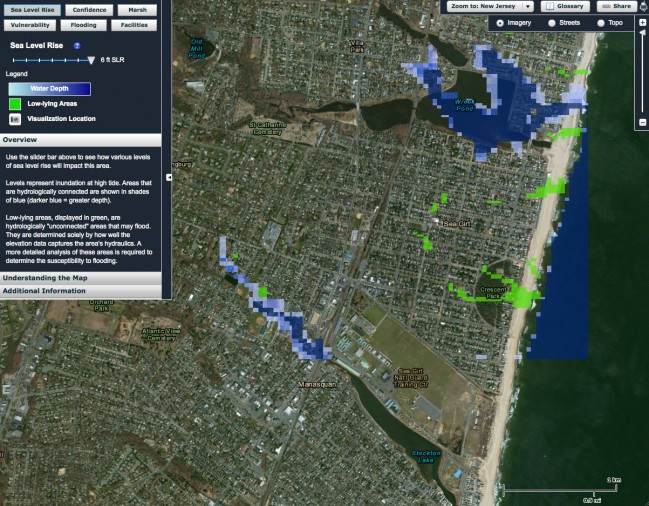
Three feet. Three feet is nothing you say. Three feet is less than the difference between the shallow and deep ends of most swimming pools. Well, when the three feet is the mean ocean level rise it becomes a little more significant. And, when that three feet is the rise predicted to happen within the next 87 years, by 2100, it’s, well, how do you say, catastrophic.
A rise like that and you can kiss goodbye to your retirement home in Miami, and for that matter, kiss goodbye to much of southern Florida, and many coastal communities around the world.
From the New York Times:
An international team of scientists has found with near certainty that human activity is the cause of most of the temperature increases of recent decades, and warns that sea levels could rise by more than three feet by the end of the century if emissions continue at a runaway pace.
The scientists, whose findings are reported in a summary of the next big United Nations climate report, largely dismiss a recent slowdown in the pace of warming, which is often cited by climate change contrarians, as probably related to short-term factors. The report emphasizes that the basic facts giving rise to global alarm about future climate change are more established than ever, and it reiterates that the consequences of runaway emissions are likely to be profound.
“It is extremely likely that human influence on climate caused more than half of the observed increase in global average surface temperature from 1951 to 2010,” the draft report says. “There is high confidence that this has warmed the ocean, melted snow and ice, raised global mean sea level, and changed some climate extremes in the second half of the 20th century.”
The “extremely likely” language is stronger than in the last major United Nations report, published in 2007, and it means the authors of the draft document are now 95 percent to 100 percent confident that human activity is the primary influence on planetary warming. In the 2007 report, they said they were 90 percent to 100 percent certain on that issue.
On another closely watched issue, however, the authors retreated slightly from their 2007 position.
On the question of how much the planet could warm if carbon dioxide levels in the atmosphere doubled, the previous report had largely ruled out any number below 3.6 degrees Fahrenheit. The new draft says the rise could be as low as 2.7 degrees, essentially restoring a scientific consensus that prevailed from 1979 to 2007.
Most scientists see only an outside chance that the warming will be as low as either of those numbers, with the published evidence suggesting that an increase above 5 degrees Fahrenheit is likely if carbon dioxide doubles.
The new document is not final and will not become so until an intensive, closed-door negotiating session among scientists and government leaders in Stockholm in late September. But if the past is any guide, most of the core findings of the document will survive that final review.
The document was leaked over the weekend after it was sent to a large group of people who had signed up to review it. It was first reported on in detail by the Reuters news agency, and The New York Times obtained a copy independently to verify its contents.
It was prepared by the Intergovernmental Panel on Climate Change, a large, international group of scientists appointed by the United Nations. The group does no original research, but instead periodically assesses and summarizes the published scientific literature on climate change.
“The text is likely to change in response to comments from governments received in recent weeks and will also be considered by governments and scientists at a four-day approval session at the end of September,” the panel’s spokesman, Jonathan Lynn, said in a statement Monday. “It is therefore premature and could be misleading to attempt to draw conclusions from it.”
The intergovernmental panel won the Nobel Peace Prize along with Al Gore in 2007 for seeking to educate the world’s citizens about the risks of global warming. But it has also become a political target for climate contrarians, who helped identify several minor errors in the last big report from 2007. This time, the group adopted rigorous procedures in hopes of preventing such mistakes.
On sea level, one of the biggest single worries about climate change, the new report goes well beyond the one from 2007, which largely sidestepped the question of how much the ocean could rise this century.
The new report lays out several scenarios. In the most optimistic, the world’s governments would prove far more successful at getting emissions under control than they have been in the recent past, helping to limit the total warming.
In that circumstance, sea level could be expected to rise as little as 10 inches by the end of the century, the report found. That is a bit more than the eight-inch rise in the 20th century, which proved manageable even though it caused severe erosion along the world’s shorelines.
Read the entire article here.
Image courtesy of the Telegraph.

